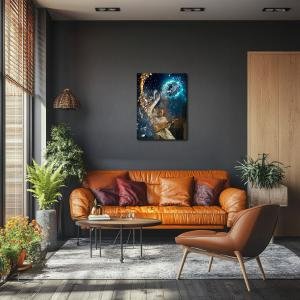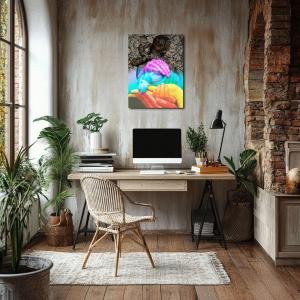Veins of Porcelain: Where Light Learns to Breathe
Veins of Porcelain: Where Light Learns to Breathe reframes Pollock’s Shimmering Substance as a radiant meditation on memory, light, and the softest layers of self. His swirling tangles of color glow like a celestial nest among sunlit silhouettes, foggy roads, and reflective waters. Warm yellows and rose-touched violets weave through human shadows and open landscapes, turning abstraction into memory’s shimmer. A woman’s figure rises into the sun—gesture, not identity. Pollock’s chaos dissolves into breath. This is not a painting of light—it’s where light goes when it forgets to burn.
Please see Below for Details…
Hotline Order:
Mon - Fri: 07AM - 06PM
404-872-4663
Veins of Porcelain: Where Light Learns to Breathe reimagines Jackson Pollock’s Shimmering Substance not as a mere dance of pigment, but as a sacred suspension—an inhale of golden breath held between thought and sunrise. In this reinterpretation, Pollock’s luminous tangle is released into the world beyond canvas, merging with silhouettes, sun-washed fields, reflective waters, and glimmers of remembered childhood. The work becomes not an abstraction of substance, but the shimmering of memory itself.
The visual architecture of this piece is built from layers of translucent life: a woman in silhouette lifts her arms into a soft burst of filtered sun, light passing through her like prayer. Beneath her, roads curve gently into fog, grasses nod over reflective water, and fields of yellow flowers flicker like daydreams against a breeze. These are not just fragments of nature; they are pieces of longing, seen through the lens of nostalgia—the moments when everything seems quiet, golden, and briefly whole.
Pollock’s original painting sits gently embedded within this collage—like a portal or seed. It pulses from within, its tangled currents of yellow, violet, and rose pink glowing with embryonic vitality. His strokes—quick, circular, cellular—now resemble the microstructures of light, the buzzing electricity inside every glance toward something meaningful. In its new placement, Shimmering Substance becomes less chaotic and more cosmic—a nebula of emotion suspended mid-breath.
The color palette is a symphony of luminosity. The background radiates soft golden hues: buttery yellows, warm creams, and pale sunbeam whites that soak into every surface like morning dew. These colors suggest not heat, but warmth—an interior glow, a safe place remembered just before waking. Pollock’s own palette is echoed and amplified here: his curled swaths of cadmium yellow now resonate with fields of sunlight. His lavender curls echo the distant fog. Pale greens and cloud-gray interweave like spring’s promise.
As an artist, my thought in shaping this reinterpretation was rooted in softness. Pollock is often read through violence—through gesture, speed, fracture. But Shimmering Substance always felt to me like his breath. It was quiet, pulsing, maternal even. I imagined what it would feel like to live inside that moment, not just to view it. What if the shimmer extended beyond the paint, into memory, into the air between shadows and reflections?
The repeated silhouette of the woman is intentional—she is memory’s embodiment. We never see her face. She exists in gesture alone, a human shaped by light and longing. She could be dancing, stretching, surrendering. She could be remembering a moment, or becoming it. That ambiguity is the pulse of this piece. She is not the subject. She is the shimmer.
Pollock’s brushwork—chaotic in isolation—now becomes part of nature’s rhythm. His paint no longer splatters with fury, but with awe. In this reinterpretation, he’s not the angry modernist flinging paint, but a boy squinting at the sun through wildflowers, trying to capture what light feels like when it rests on your skin. His gestures soften. His energy becomes something cellular, something alive.
Veins of Porcelain: Where Light Learns to Breathe is not a vision of clarity. It’s a meditation on those unspoken fragments that hover just before memory, the shimmer of a thought not yet shaped into language. It is a landscape painted in scent and hush, stitched from the radiant pieces of time we wish we could hold longer. Pollock’s substance is not oil or enamel here. It is breath, joy, golden ache.
Add your review
Your email address will not be published. Required fields are marked *
Please login to write review!
Looks like there are no reviews yet.








